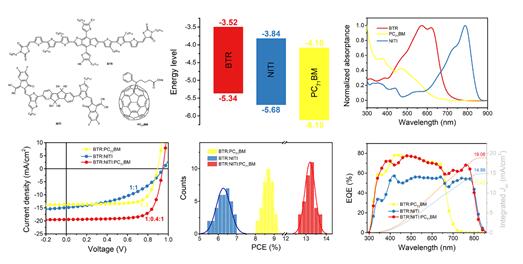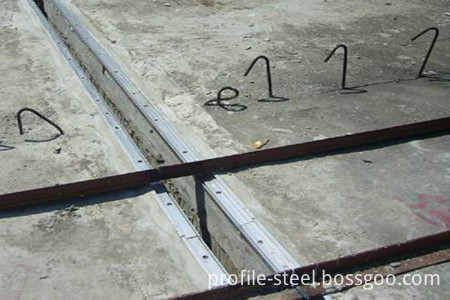Organic solar cells with remarkable characteristics such as adjustable band gap height, light weight, flexibility and low cost are important development directions of new generation photovoltaic technology. Organic solar cells are limited by the "narrow absorption" characteristics of organic materials, binary blended films are difficult to achieve effective wide-spectrum utilization of solar energy, and there are always phase blending (facilitating exciton dissociation) and phase separation (facilitating charge transfer) This fundamental contradiction restricts further breakthroughs in the performance of organic photovoltaic devices. The ternary organic solar cell maintains a single-cell structure, and introduces a complementary third component into the binary active layer to enhance spectral absorption. Although the ternary battery has achieved certain success, it still faces severe challenges. The core problem is that it is difficult to achieve clear and effective morphology control of the ternary blend film to ensure efficient exciton dissociation and charge transfer. Therefore, it has been reported that the performance improvement of the ternary battery is relatively low.
With the support of the National Natural Science Foundation of China, the Ministry of Science and Technology and the Chinese Academy of Sciences, the research team of Zhu Xiaozhang, a researcher of the Key Laboratory of Organic Solids, Institute of Chemistry, Chinese Academy of Sciences, used the thienothiophene photovoltaic receptor new material NITI (Adv. Mater.2017,29,1704510), choose the binary system reasonably, construct the morphology of the ternary active layer with “hierarchical structureâ€, realize the substantial improvement of the photoelectric conversion efficiency, and explain the morphology to the photoelectric process and device parameters Decisive impact, related papers were published in the journal Nature-Energy (NatureEnergy, DOI: 10.1038 / s41560-018-0234-9).
The ternary blended thin films were selected from strong crystallization, wide band gap electron donor material BTR, weak crystallization, narrow band gap electron acceptor material NITI, and fullerene acceptor PC71BM with strong aggregation and excellent electron transport characteristics, the three formed Favorable gradient electronic structure and complementary light absorption. After optimized device preparation, the above-mentioned three components achieved the highest photoelectric conversion efficiency of 13.63% (average 13.20%) at the optimal film thickness of 300nm, and the performance improvement of the two components was as high as 51% and 100%. The highest performance record of the battery is also the thick-film (> 200nm) organic solar cell with the best performance. They cooperated with the relevant research groups of Shanghai Jiaotong University and Linköping University in Sweden to propose a new morphology of the ternary active layer of "hierarchical structure": NITI and BTR are highly blended to form a small phase separation fine structure that is conducive to charge separation. PC71BM is in BTR A large-scale phase separation structure and favorable face-on accumulation are formed around the periphery of the blending zone with NITI. The researchers proved that the NITI receptor plays an important role in the photoelectric process. On the one hand, it inhibits the contact between BTR and PC71BM, so that the three components obtain a low-loss open circuit voltage comparable to the second component (BTR: NITI); PC71BM is active A high-speed electron transmission path is formed in the layer, and the electrons separated by NITI are effectively transported to the electrode, thereby ensuring high external quantum efficiency (EQEs) and fill factor (FF).
Overall, this work has designed and implemented a new morphology of the active layer of organic ternary batteries, and has fully utilized the unique advantages of small molecules and fullerene electron acceptors in organic solar cells, while achieving high open voltage and high current And high fill factor, provide a new idea for the morphology control of organic ternary battery active layer.

Figure 1. Chemical structure, energy level arrangement, absorption spectrum and device performance

Figure 2. Schematic diagram of hierarchical structure and performance statistics of organic solar cells
Aluminum Type Profile
Aluminum type profile is a important part of profile.It includes window&door aluminum profile, industrial aluminum profile, aluminum tile trim profiles and so on.
Aluminum type profile commonly have a long lifespan.The surface treatment of aluminum profile is very important.The surface methods include powder coating ,anodized,galavanized and so on.J.S.Brown can supply all kinds of aluminum profiles according to your requirements.Due to the high quality,we have exported to many countries.
Pictures of Application


Aluminium Profile,Section Aluminum,Industrial Aluminum Profiles,Hot Rolled Aluminium Profile
J.S.Brown New Material Technology Co., Ltd. , https://www.profile-steel.com